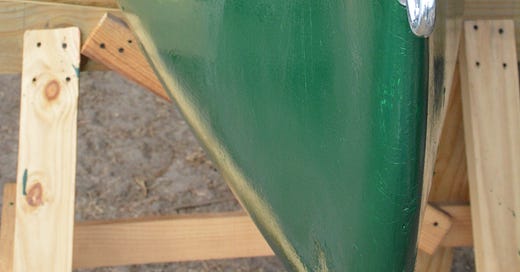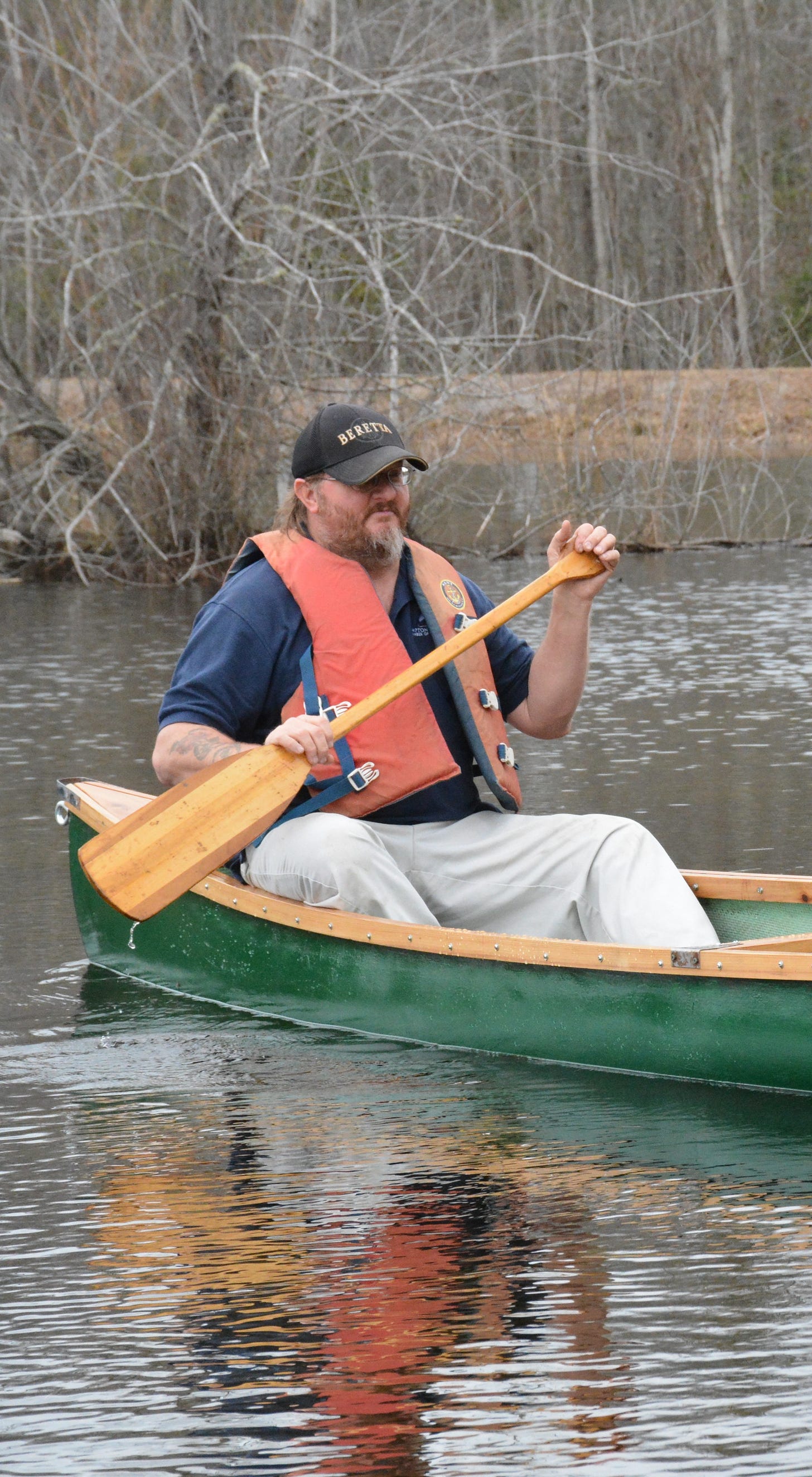Just as the Phoenix has risen from the murky depths of the Coosawhatchie, I have been reborn as well.
I had abandoned her.
She was 17 feet of fiberglass beauty and strength, a canoe built tough like they used to make them when cars were forged of steel in American cities and everything a family needed could be ordered from a Sears & Roebuck catalog.
She was at least as old as I am, mid-40s, pushing 50 hard. The old darling had no doubt enjoyed many trips to the freshwater Combahee, salty coastal waters, and everything brackish in between, and was later gifted to an uncle and then to my father. This hand-me-down canoe has floated my family on the wide waters of the Santee Cooper, and has taken us into some tight places in the tangled, ebony-river swamps where a lady of such large frame had no business going. Dad often told me how he could put me down on a tackle box between his feet, and even as a toddler I would sit patiently and fish for hours.
Then she was passed down to me. She was mine, but I wasn’t ready. Still in my irresponsible 20s, I took her swamp fishing with some drinking buddies then thoughtlessly abandoned her at a place called Pike Lake. By the time I remembered her months later, she had been scuttled by rain and neglect to the bottom of the Coosawhatchie River. There she sat for more than a year, subjected to the rising and falling floodwaters, rotting from bow to stern.
The canoe wasn’t all I abandoned during this tumultuous time of my life. I quit college after one semester, then turned my back on family to pursue shallow, self-destructive ends, as too many young men and women do. Several years and many bad decisions later, I had become depressed, lonely, in despair. On a hot August night, I found myself behind county jail bars with no job, no car or driver’s license, with my aching head in my hands and a sour taste in my mouth.
I had hit the proverbial rock bottom. I had lost my way.
A place in history, and in our hearts
When the ancient Polynesian explorers needed to find their way, they looked to the stars, to the shapes and colors of clouds, to the movements of winds, currents, waves and birds. The elders told stories and sang songs that marked populated island chains; they passed on the secrets of primitive charts and instruments to help future generations venture even farther across thousands of blue leagues of vast Pacific to their destiny. They were called wayfinders, and there are few like them left in this world.
These archaic mariners built strong, giant seagoing canoes with double hulled designs, sails and outriggers. During the Austronesian migration period from roughly 3000 to 1000 BC, Polynesian canoes spread bloodlines, traditions, language and culture across what is now known as the Polynesian Triangle and beyond, voyaging from Southeast Asia as far west as Madagascar, south beyond New Zealand, and—some evidence suggests—as far east as the Americas. Canoe traditions are so important to the Maori, the indigenous Polynesian people who arrived in New Zealand in several waves of canoe voyages, that modern-day descendants do not trace their genealogy just by family name, but also by which canoe their ancestors arrived on.
The remains of the oldest known canoe, the Pesse Canoe, were discovered in the Netherlands and believed to have been constructed between 8200 and 7600 BC. The Native Americans fabricated canoes using everything from buffalo hides to giant cedar logs. Canoes have been used in almost every corner of the world and played a particularly important role in the history and exploration of countries like the United States and Canada, from the days of the Hudson Bay Company to the Lewis and Clark expedition.
Our friend the canoe has earned its place in literature, folklore and popular culture. In Canada, the canoe once adorned the silver dollar and there is a popular French Canadian tall tale, the Chasse-galerie, in which the Devil magically propels a canoe through the air but tricks the voyagers out of their souls. In John Steinbeck’s novella, The Pearl, the diver uses a canoe to scratch out a living in a tradition that had been passed down for generations.
Canoes have an important place in our history, and even today, if we have a spirit for exploration and a skill for finding our way.
Born again
When I was totally lost in the sea of life, love became my wayfinder, my compass. The undying support of my family and my wife Valerie, followed by the birth of our first son, guided me through the squalls of life and on to brighter horizons. I finished my education and built a career. I became a writer and an award-winning journalist. We built a family and a home. When my sons were born, I vowed to give them a wholesome life spent with family, with time spent outdoors, enjoying all the adventures that my father had shared with me.
I stumbled upon that abandoned canoe more than a decade later, weathering away in the family junkyard. Dad had pulled it from the mud and mire, no doubt cursing the name of his first born. The boat tugged at my heart. She called to me. She longed to be whole, to float under the stars again, and something inside of me longed to pilot her just one more time. Or perhaps it was the ancients speaking to me, urging me to do what our brave race has done for millennia—explore and be one with our natural world. The adult in me also wanted to take some responsibility for what I had done, to right this wrong. I longed to see my child sitting on a tackle box at my feet. So I began the difficult task of restoring this family heirloom.
(The author and The Phoenix at the start of the canoe restoration project.)
It was not an easy task, nor did it get done quickly. I worked on it here and there for more than a year. There was rotten wood and rusted metal to be cut away, holes in fiberglass to be patched and sealed with resin. I had to special order marine-grade paint. When all that was rotten had been stripped away, it was time to build her anew, to replace what crumbled with something of strength. New wood had to be cut, planed, sanded, painstakingly bent into place, then sealed and varnished. I chose cypress. A cousin to the giant redwood and sequoia, the bald cypress (Taxodium distichum) is the largest and longest living tree east of the Mississippi. A native swamp dweller, the cypress can easily live to be a thousand years old or more. Cypress is light, yet strong and stable, naturally rot resistant and prized by boat builders worldwide because it is downright beautiful. I knew right away this fine wood was meant to become a part of my canoe.
When I began this project, I was simply looking to patch and repair. But as I worked, I strangely felt that restoring the canoe was somehow putting the final patches on my once-tattered life. Best of all, I had the chance to spend many afternoons with my aging father, working together on this canoe that will hopefully outlast us both and serve his grandchildren well. Perhaps the ancients will speak to my children as they have communed with me, singing songs of latitude and lost islands, sharing tales of adventure, urging them to explore their natural world.
(The Phoenix floats again, and I have once again found my way.)
I found an old compass in a box of my grandfather’s things and mounted it on the bow of the restored canoe, partly because I thought it added a cool touch, and partly to remind me to look to nature and my family for direction and never lose my way again. She is my vessel now, and I will call her Phoenix. The Native Americans modeled their canoes after mythical creatures and symbols, and the Phoenix is a symbolic creature of beauty and quiet, enduring strength, bursting into flames of self destruction only to rise anew again, stronger, wiser. Just as The Phoenix has risen from the murky depths of the Coosawhatchie, I have been reborn as well.
As a young man, I spent too many years tossing about in troubled waters. Perhaps this canoe project is a symbol of my soul’s journey: a vessel once anchored in family and in touch with nature, but finding itself off course and drifting lost under the stars until the skilled hands of a wayfinder comes along to guide it to safe shores.
Or perhaps she is just a boat, and I am just a silly, sentimental writer and a corny old fool.
But she floats now, and she is beautiful and whole again. And my children will float in her, guided by their stars. That is all that matters.







Wow. I love this so much!